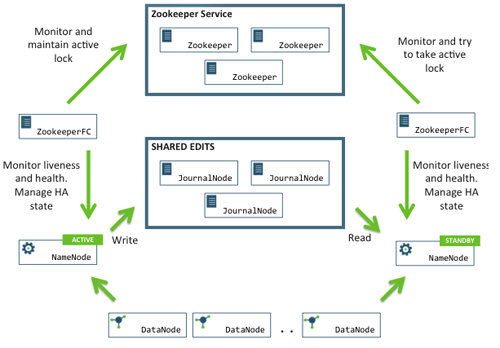The preceding sections describe how to configure manual failover. In that mode, the system will not automatically trigger a failover from the active to the standby NameNode, even if the active node has failed. This section describes how to configure and deploy automatic failover.
Automatic failover adds following components to an HDFS deployment:
ZooKeeper quorum
ZKFailoverController process (abbreviated as ZKFC).
The ZKFailoverController (ZKFC) is a ZooKeeper client that monitors and manages the state of the NameNode. Each of the machines which run NameNode service also runs a ZKFC. ZKFC is responsible for:
Health monitoring: ZKFC periodically pings its local NameNode with a health-check command.
ZooKeeper session management: When the local NameNode is healthy, the ZKFC holds a session open in ZooKeeper. If the local NameNode is active, it also holds a special "lock" znode. This lock uses ZooKeeper's support for "ephemeral" nodes; if the session expires, the lock node will be automatically deleted.
ZooKeeper-based election: If the local NameNode is healthy and no other node currently holds the lock znode, ZKFC will try to acquire the lock. If ZKFC succeeds, then it has "won the election" and will be responsible for running a failover to make its local NameNode active. The failover process is similar to the manual failover described above: first, the previous active is fenced if necessary and then the local NameNode transitions to active state.

Use the following instructions to configure and deploy automatic failover:

